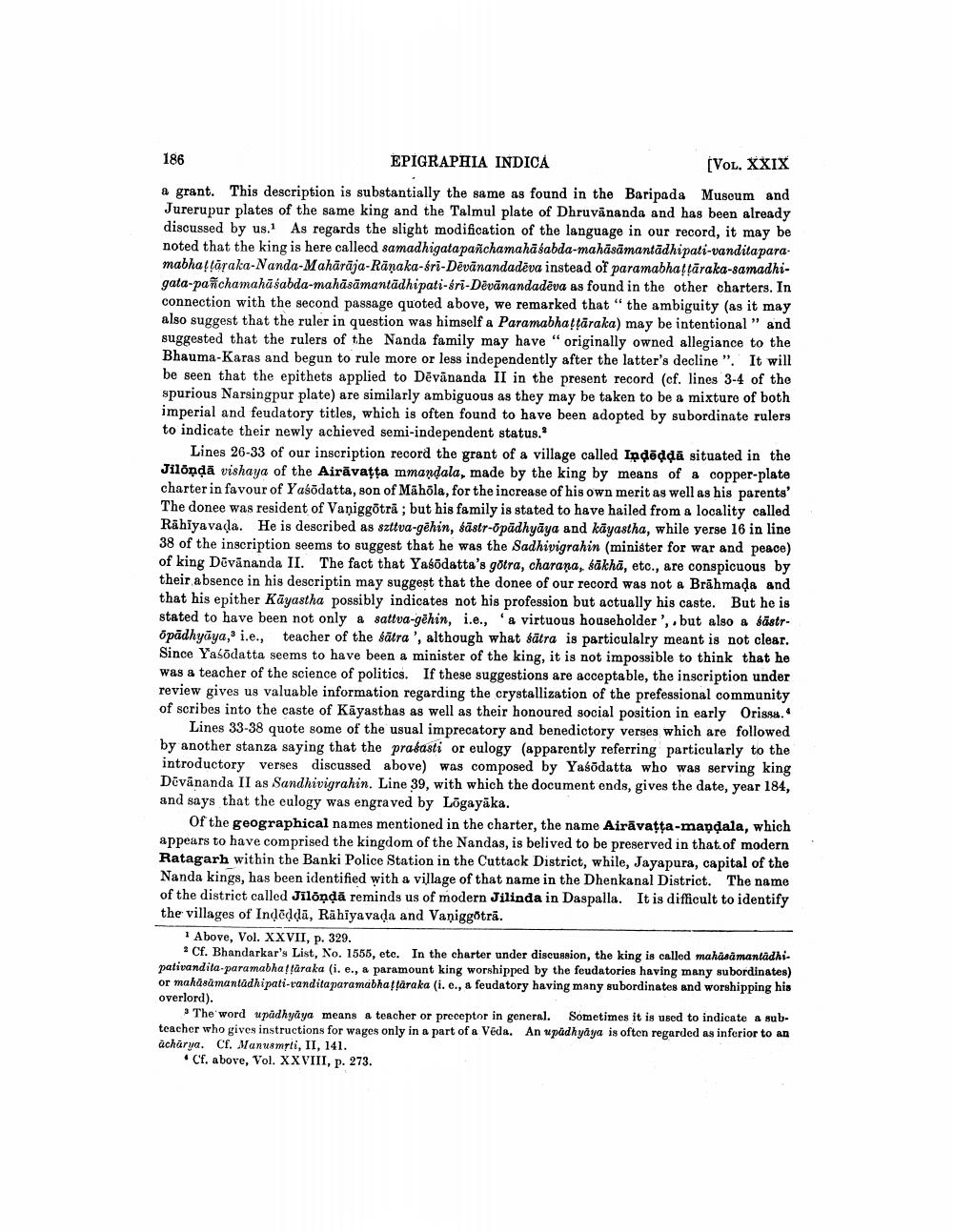________________
186
EPIGRAPHIA INDICA
(VOL. XXIX
a grant. This description is substantially the same as found in the Baripada Museum and Jurerupur plates of the same king and the Talmul plate of Dhruvānanda and has been already discussed by us. As regards the slight modification of the language in our record, it may be noted that the king is here called samadhigatapanchamahā sabda-mahāsāmantādhipati-vanditaparamabhatlāraka-Nanda Mahārāja-Rāņaka-eri-Dēvānandadëva instead of paramabhattāraka-samadhigata-paschamahāśabda-mahāsāmantādhipati-sri-Dēvānandadēva as found in the other charters. In connection with the second passage quoted above, we remarked that " the ambiguity (as it may also suggest that the ruler in question was himself a Paramabhattāraka) may be intentional ” and suggested that the rulers of the Nanda family may have "originally owned allegiance to the Bhauma-Karas and begun to rule more or less independently after the latter's decline". It will be seen that the epithets applied to Dēvānanda II in the present record (cf. lines 3-4 of the spurious Narsingpur plate) are similarly ambiguous as they may be taken to be a mixture of both imperial and feudatory titles, which is often found to have been adopted by subordinate rulers to indicate their newly achieved semi-independent status.'
Lines 26-33 of our inscription record the grant of a village called Indoddā situated in the Jilondā vishaya of the Airāvaţta mmandala, made by the king by means of a copper-plate charter in favour of Yasõdatta, son of Māhõla, for the increase of his own merit as well as his parents' The donee was resident of Vaniggötrā; but his family is stated to have hailed from a locality called Rāhiyavada. He is described as szttva-gehin, śāstr-opādhyāya and kāyastha, while yerse 16 in line 38 of the inscription seems to suggest that he was the Sadhivigrahin (minister for war and peace) of king Divānanda II. The fact that Yasodatta's gotra, charana, śākhā, etc., are conspicuous by their absence in his descriptin may suggest that the donee of our record was not a Brāhmada and that his epither Kāyastha possibly indicates not his profession but actually his caste. But he is stated to have been not only a sattva-gehin, i.e., & virtuous householder', . but also a sästr. opādhyāya,' i.e., teacher of the sätra ', although what sätra is particulalry meant is not clear. Since Yasõdatta seems to have been a minister of the king, it is not impossible to think that he was a teacher of the science of politics. If these suggestions are acceptable, the inscription under review gives us valuable information regarding the crystallization of the prefessional community of scribes into the caste of Kāyasthas as well as their honoured social position in early Orissa.
Lines 33-38 quote some of the usual imprecatory and benedictory verses which are followed by another stanza saying that the prasasti or eulogy (apparently referring particularly to the introductory verses discussed above) was composed by Yaśõdatta who was serving king Divānanda II as Sandhivigrahin. Line 39, with which the document ends, gives the date, year 184, and says that the eulogy was engraved by Lögayāka.
Of the geographical names mentioned in the charter, the name Airāvaţta-mandala, which appears to have comprised the kingdom of the Nandas, is belived to be preserved in that of modern Ratagarh within the Banki Police Station in the Cuttack District, while, Jayapura, capital of the Nanda kings, has been identified with a village of that name in the Dhenkanal District. The name of the district called Jilondā reminds us of modern Jilinda in Daspalla. It is difficult to identify the villages of Indoddā, Rāhiyavada and Vaniggötrā.
1 Above, Vol. XXVII, p. 329.
2 Cf. Bhandarkar's List, No. 1555, etc. In the charter under discussion, the king is called mahasamantadhi. pativandita paramabhalaraka (i. e., a paramount king worshipped by the feudatories having many subordinates) or mahasumantadhipati-vandita paramabhaffaraka (i. e., a feudatory having many subordinates and worshipping his overlord).
The word upadhyāya means a teacher or preceptor in general. Sometimes it is used to indicate a subteacher who gives instructions for wages only in a part of a Veda. An upůdhyāya is often regarded as inferior to an acharya. Cf. Manusmrti, II, 141.
. Cf. above, Vol. XXVIII, p. 273.




